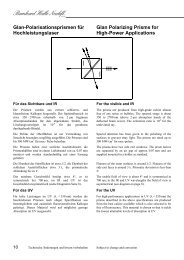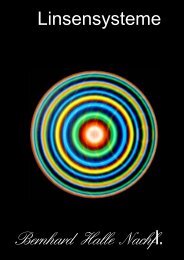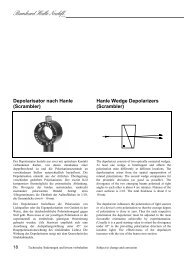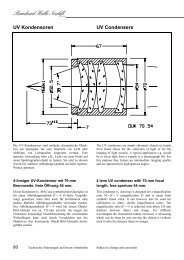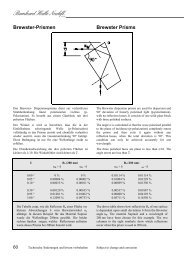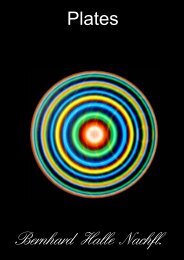Wollaston- und Rochon - Bernhard Halle
Wollaston- und Rochon - Bernhard Halle
Wollaston- und Rochon - Bernhard Halle
Erfolgreiche ePaper selbst erstellen
Machen Sie aus Ihren PDF Publikationen ein blätterbares Flipbook mit unserer einzigartigen Google optimierten e-Paper Software.
Das System ist speziell für Anwendungen konstruiert, in<br />
denen ein leichter, offener Zugang zu allen Einzelteilen<br />
erwünscht ist; eine für räumlich eingeschränkte<br />
Anwendungen optimierte Version ist auf Seite 67<br />
beschrieben.<br />
Die Konstruktion dieses Raumfilters ermöglicht, die beiden<br />
wesentlichen Justagevorgänge (Fokussierung längs der<br />
optischen Achse <strong>und</strong> Blendenjustage in zwei Richtungen<br />
senkrecht dazu) vollständig unabhängig voneinander<br />
auszuführen, <strong>und</strong> das Aufweitungsobjektiv (Mikroobjektiv)<br />
auf einfache Weise zu wechseln.<br />
Dieses Raumfilter ist aus drei Baugruppen zusammengesetzt:<br />
es besteht aus einem Objektivfokussierteil<br />
MRF 56.1 (in der Mitte des obigen Photos, mit einem<br />
Reiterstift ∅ 14 mm), einem Blenden-Justierteil MRF 56.2<br />
(rechts im Photo), das auf das Fokussierteil aufgesetzt wird,<br />
<strong>und</strong> einer Objektivhalterung als ein Teil von MRF 56.1<br />
(links im Bild, mit einem Mikroobjektiv), das in das<br />
Fokussierteil eingesetzt wird. Die beiden Justierteile sind<br />
mit Nut <strong>und</strong> vier Klemmschrauben verb<strong>und</strong>en; die Teile<br />
können auch einzeln geliefert werden.<br />
Die kurzbrennweitigen Objektive zur Fokussierung in die<br />
Raumfilterblende werden mit konventionellem RMS-<br />
Mikroskopgewinde in die Objektivhalterung eingeschraubt<br />
<strong>und</strong> in den Fokussierteil eingesteckt, so dass der Brennpunkt<br />
etwa in der Ebene der Lochblende liegt. Ein Rändelring<br />
am Fokussierteil ermöglicht dann eine Feinfokussierung<br />
ohne Mitdrehung der Optik. Die Objektive<br />
müssen mindestens 0,2 mm freien Arbeitsabstand haben.<br />
Im Blenden-Justierteil werden die gefassten Lochblenden<br />
mit einer seitlichen Klemmschraube gehalten <strong>und</strong> sind<br />
leicht auswechselbar. Zur Justage des Raumfilters kann die<br />
Blende mit zwei Mikrometerschrauben in X- <strong>und</strong> Y-<br />
Richtung feinfühlig verschoben werden. Eine seitliche<br />
Einblicköffnung in das Blenden-Justierteil erleichtert die<br />
Justierung.<br />
This system is constructed especially for applications which<br />
require easy and open access to all the individual parts; a<br />
version optimized for applications in which space is limited<br />
is described on page 67.<br />
The construction of this spatial filter ensures that the two<br />
key adjustment processes (focusing along the optical axis<br />
and aligning the pinhole in two directions perpendicular to<br />
it) are completely independent of one another and makes it<br />
possible to interchange the expansion objective (micro<br />
objective) in a simple way.<br />
This spatial filter is an assembly of three modules: an<br />
objective focusing unit MRF 56.1 (the middle part in the<br />
above photograph, with a 14 mm diameter mounting post);<br />
an adjustable pinhole attachment MRF 56.2 (on the right in<br />
the photograph) which is mounted on the top of the<br />
focusing unit; and an objective holder, which is part of<br />
MRF 56.1 (on the left in the photograph, shown with an<br />
objective). The two adjustable parts are connected together<br />
by a groove and four clamping screws. The parts can also<br />
be ordered individually.<br />
The short focal length objective for focusing into the<br />
pinhole is screwed into the objective holder (left item on<br />
above photo) by means of a standard RMS microscope<br />
thread and then inserted into the focusing unit so that the<br />
focal point is approximately at the pinhole plane. A knurled<br />
ring on the focusing unit makes it possible to fine focus<br />
without rotation of the optics. The objectives must have at<br />
least 0,2 mm free working distance.<br />
In the adjustable pinhole unit the mounted pinholes are held<br />
by a side clamping screw and are easily interchangeable.<br />
For adjustment of the spatial filter the pinholes can be<br />
smoothly moved in X or Y direction by two micrometer<br />
screws. A side viewing opening in the adjustable unit<br />
facilitates the adjustment.<br />
Technische Änderungen <strong>und</strong> Irrtum vorbehalten Subject to change and correction 65



